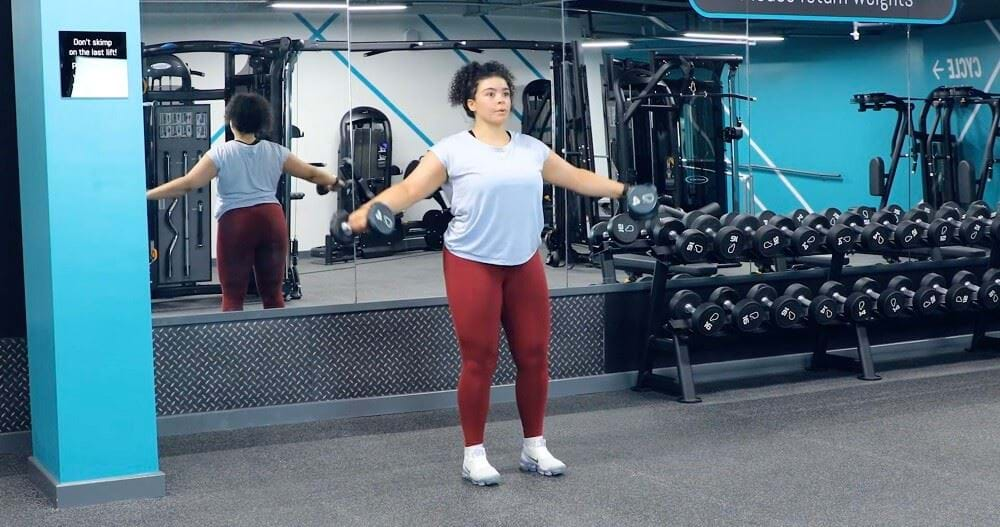Dumbbell Lateral Raise
What Is A Dumbbell Lateral Raise?

Dumbbell lateral raises are a shoulder exercise that target the lateral deltoids (outer shoulders) and trapezius muscle (upper back). The lateral deltoids are the largest of the three muscles that make up the shoulders and give your shoulders their capped look.
Dumbbell lateral raises do more than build aesthetic shape in the shoulders. The shoulders are very mobile joints, because the deltoids are connected to lots of other muscles and bones in the upper back, neck, and shoulder area. This range of movement helps you lift, push, and pull, but can put you at risk of injury. Strengthening the lateral delts and traps helps to strength and stabilise the complex musculature of the shoulder girdle and reduce risk of injury.
Dumbbell lateral raises are a versatile lateral raise exercise that can be adapted to your fitness level and goals. You can do dumbbell lateral raises with both arms at the same time or single arm, with different weights of dumbbells, and by changing the angle of your body to increase or decrease the intensity.
Dumbbell lateral raises work well with other arm and shoulder exercises like front raises, rear delt exercises, and upright rows to build all-round strength, size, and aesthetics in the shoulder area.
Check out some other lateral raise exercises: Cable Lateral Raise, Seated Lateral Raise
Commonly Asked Questions About Dumbbell Lateral Raises
Lateral raises mostly work the lateral deltoids which are the largest muscle of the shoulders. The lateral delts are the middle of the three shoulder muscles, and are the ones that give the shoulder most of its size and round shape. Lateral raises also work the trapezius muscle across the top of the upper back.
Lateral raise exercises are classed as a push exercise because the main muscle doing the work is the lateral deltoid muscle of the shoulder. If you split your workouts by push, pull, legs, it is best to do lateral raises on a push day with other shoulder exercises.
Yes, lateral raises help to build muscle in the shoulders and upper back, primarily the lateral deltoid muscles of the shoulder and the trapezius in the upper back. They are a good choice of exercise for strengthening and stabilising the complex shoulder joint.
Lateral raises are an isolation exercise, not a compound exercise. This is because only one joint moves when you are performing a lateral raise -- the shoulder joint. Lateral raises also isolate the lateral head of the joint rather than recruiting the entire shoulder. They should be combined with upper body compound exercises like the shoulder press for best results.
Cable Lateral Raise Tips
Brace your core and squeeze your glutes to provide a stable base for the exercise.
Keep the lateral raise movement steady and smooth, don’t jerk the dumbbells up.
Avoid using your legs to provide momentum as this shifts tension away from the lateral delts. Instead, choose a weight that allows you to raise and lower the weights with control.
Think about keeping your little finger slightly higher than your thumb to activate the lateral head of the deltoid muscle.
How To Do Dumbbell Lateral Raise
Stand with your feet shoulder-width apart, holding a dumbbell in each hand.
Start with the dumbbells by your sides, palms facing inwards.
Engage your core and squeeze your glutes, then raise your arms out to the sides without using your legs for momentum.
Keep your palms facing downwards and your little finger slightly higher than your thumb.
Maintain a small bend in your elbows throughout the movement.
Stop when your hands reach shoulder height and your arms are slightly in front of your torso.
Pause before slowly lowering the dumbbells back to the start position with control.
If you’re not sure if any of the above exercises are suitable for you, please consult your doctor before you start it. Need guidance on how to perform the exercise? Ask a personal trainer at your gym.